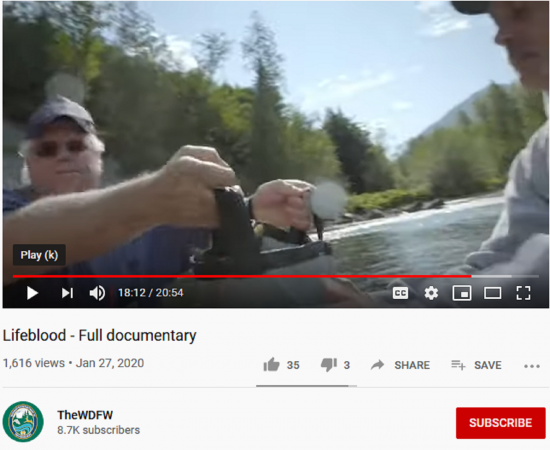Puget Sound Anglers’ Garner Gives His To ‘Lifeblood’ Documentary
A key member of Western Washington’s sportfishing community appeared in a new documentary this week urging often at-odds salmon stakeholders to work together to recover habitat and runs.
“We’ve been fighting over the last fish for far too long and it hasn’t worked,” Ron Garner, Puget Sound Anglers state board president, says in Lifeblood. “We used to fight with the tribes constantly. Finger-pointing, blaming. We don’t want to do that anymore, we want to bring our salmon runs back.”

The 20-minute production posted by WDFW focuses on anglers, tribes, farmers and fishery scientists working towards that end in Snohomish County’s lower landscapes, a key area for diminished fish stocks.
“Now we talk about how to fix things instead of how to get that last fish from each other,” Garner adds.
It’s a strong step, given the history, yet even as he pushes to end the fighting with the tribes, others see battles worth fighting.
GARNER, WHO LIVES IN MONROE, SITS ON SEVERAL WDFW advisory committees, including Budget and Policy, and is one of 50 members of Governor Inslee’s Southern Resident Orca Task Force, on which he defended fisheries and hatchery production that others wanted to cut to save the whales.
Self-employed, as the head of Western Washington’s most influential fishing organization, Garner can often be seen testifying in Olympia before the legislature or the Fish and Wildlife Commission on salmon-related issues.
In mid-2018 he had the extremely rare honor for a nontribal member — let alone a sport fisherman — of attending a Northwest Indian Fisheries Commission meeting, and he is a nontribal core/leadership member of the Billy Frank Jr. Salmon Coalition, named after a key player in 1974’s Boldt Decision.
In one part of Lifeblood, Garner and Shawn Yanity, chair and fisheries manager for the tiny Stillaguamish Tribe, smile on the banks of the Stillaguamish River.
In a Facebook post last summer, Garner called that a “special day,” one in which he was “honored” to help as the tribe collected Chinook for their broodstock program.
Due to perpetually low numbers because of the highly altered state of habitat in their basin, Stillaguamish kings are one of the most constraining stocks on Puget Sound salmon fisheries.
With two-thirds of these Endangered Species Act-listed fish caught in British Columbia and Alaska fisheries, literally where each one is intercepted down here matters immensely. To get as many back to the Stilly as possible requires restricting local seasons because of how the fish mix with other stocks in our saltwaters.
To ever be able to ease those constraints, much more of the river system’s habitats need to be reclaimed and become more productive for more young Chinook.
Indeed, Lifeblood identifies the lack of rearing space in the estuaries as the “main bottleneck” for the survival of young Chinook before they face the dangers as well as feeding opportunities in Puget Sound and the North Pacific.
“I spent some time right here in my backyard, Snohomish River system,” says Garner in the film, “and I went out and I looked and I really started looking at how the habitat is connected. And boy did we break it. I mean, it’s so obvious when you look at it. We’ve got a lot of things that need to be cleared up and fixed.”
Somewhere in the heavens Bob Heirman is smiling; he would smile wider to fish the Stilly.
For the Stillaguamish Tribe, which unlike others is limited to only fishing the Stillaguamish, it’s a matter of identity that these Chinook not go extinct.
“They’ve always fed our people. They’re one of the links between us and the river,” Yanity told The Herald of Everett a few years ago. “They’re in our songs, they’re in our stories, they’re in our creation.”
The tribe’s conservation hatchery annually produces up to 200,000 wild-origin smolts, but adult spawner numbers in the Stillaguamish have dropped from an average of roughly 1,000 in the 1990s to 550 or so this past decade — just 150 fish above a federally identified critical level.
Last year’s fishery agreement allowed the tribe to only net 15 for ceremonial purposes.

REACTION TO LIFEBLOOD HAS BEEN MIXED, with strong support from some on WDFW’s Facebook page, but others calling for more hatchery production, ending gillnetting and controlling the number of harbor seals in Puget Sound.
[Beside habitat, pinnipeds are the other proverbial bull in the china shop: Former WDFW director and current chair of the Pacific Fishery Management Council Phil Anderson touched on that during a recent Fish and Wildlife Commission meeting on the 10-year Puget Sound Chinook plan when he offered his personal opinion to say, “In my mind, I think the data pretty clearly shows that if we are not able to do something to reduce the level of predation, all of the actions in the world that we do on the fisheries side of the equation are going to literally be eaten up. I don’t think we should shy away from trying to address this, even though it’s a very, very difficult issue.”]
Others reacting to the documentary focused on North of Falcon, the annual salmon-season-setting process between the state and tribes mostly negotiated behind closed doors and the subject of a lawsuit. The film was referenced in a letter to the Fish and Wildlife Commission yesterday.
In a phone call earlier this week, one man objected to a beached tribal fishing boat — from a scene in the film — metaphorically parked front page above the fold on WDFW’s homepage.
And with the agency’s hand perpetually out for more funding, the cost to produce it was also raised. Couldn’t that money have been used for other things?
According to spokeswoman Rachel Blomker, the agency used a $50,000 grant from the National Oceanic and Atmospheric Administration’s Coastal Resilience Grant Program to have CaravanLab produce it.
Per NOAA, resilience grants are awarded to projects that help “restore, increase, and strengthen natural infrastructure — the landscapes that help absorb the impacts of storms and floods — to ultimately protect coastal communities from storm and flooding impacts and enhance fish and wildlife habitat.”
ULTIMATELY, LIFEBLOOD ISN’T JUST ABOUT recovering salmon. It’s about WDFW trying to make itself more resilient in the coming decades by appealing to a wider audience. Expect to hear more about this as the agency’s 25-year planning comes out.
In the here and now, there will always be rough-and-tumble allocation battles over how to split harvestable surpluses, especially as our resources are stretched thinner and thinner and thinner.
But in this new documentary, one Puget Sound angler — Ron Garner — has seen that some fellow local fishermen are in just as bad shape and has waded into a shared troubled river to lend his strength and voice to a common cause.

